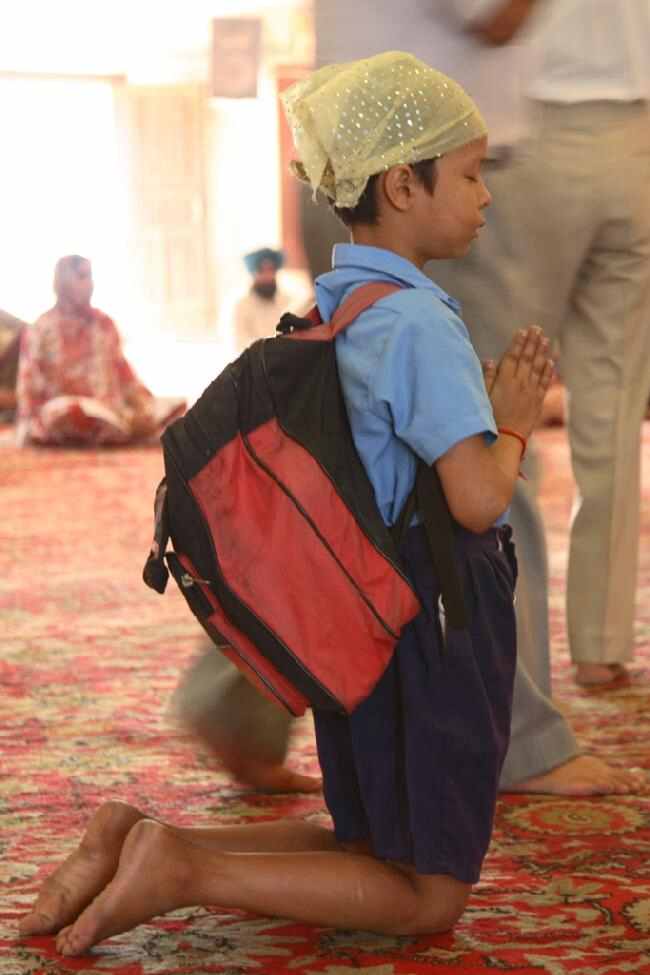
Indian Sikhism

Figure 1.--Here we see a Kilh boy praying in a Gurdwara temple. Given he is wearing his school bag, perhaps he is asking for help on a test. The cloth on his head is like what the visitors can buy at the temple so they can visit. Today not all Sikh boys respect the tradition of covering the head.
|
|
Sikhism is a monotheistic religion. Islam futher intensified the religious ferment of the sub-continent. The Islamic prohnibition on idoltry was particularly significant. New religious sects preached against idolatry as well as polytheism and caste. Here the Sikhs were especially important. Guru Nanak (1469-1538) founded Sikism. He was a Punjabi, born in Talwandi Lahore which is now part of Pakistan. India is more accepting of religious diversity than Muslim Pakistan. Sikism is based on the teachings of Guru Nanak and the teachings of the nine Sikh gurus who followed Nanak. Sikhism is an attempt to recocile the two main religions of India, Hinduism and Islam. Numbering approximately 23 million worldwide; over 60 percent of Sikhs live in the Indian state of Punjab, where they form about two-thirds of the population. Men and boys don't cut hair, but they roll up and cover it. The adults wear the characteristic turban, the boys a cloth. Entering in the Gurdwara (the temple) also no Sikh people must cover the head, besides take off the footwear.
Theology
Sikhism is a monotheistic religion. Islam futher intensified the religious ferment of the sub-continent. The Islamic prohnibition on idoltry was particularly significant. New religious sects preached against idolatry as well as polytheism and caste. Here the Sikhs were especially important. Guru (teacher) Nanak (1469-1538) founded Sikism. He was a Punjabi, born in Talwandi Lahore which is now part of Pakistan. Sikism is based on the teachings of Guru Nanak and the teachings of the nine Sikh gurus who followed Nanak. The tenth Guru, Guru Gobind Singh declared that there would be no other living Sikh Gurus, but followers instead should look o their holy scriptures for spiritual guidance. Thus the holy book in Sikhdom has become the 'Guru'. The Sikh scripture is a book called the Guru Granth Sahib. The Guru Granth Sahib is a collection of teachings and writings by Guru Nanak and other Gurus as well as Sikh, Hindu and Muslim saints. Sikhism at its heart is an attempt to recocile the two main religions of India, Hinduism and Islam.
The Punjab
Most Sikhs lived in the Raj state of the Punjab along with Muslims and Hindus. The mostly Muslim western Punjab at partition ws made the Pakistanis Punjab Province. The mostly Sikh and Hindu eastern Punjab became India's Punjab state. Most Sikhs like Hindus sid notvwant to live in a Muslim controlled country. Most Hindus and Sikhs living in the west, and Muslims lived in the east decided asfter partition to move. Theresult was a vast migration and intercommunal violence. Two cities became an issue--Lahore and Amritsar. British authorities were unsure wherecto draw the boundary as the population was so mixed. Finally the Btitish assigned Lahore to Pakistanand Amritsar to India. Amritsar was especially important to the Sikhs because their golden temple was located there. There was terrible inter-communl violence. In the west Punjab assined to Pakistan, there were areas with substantial Sikh populations (Lahore, Rawalpindi, Multan, and Gujart). Muslim extremidts organizations attacked the Sikhs. Many were killed. There were many Musilms in the East Punjab (especially Amritsar, Ludhiana, and Gurdaspur). Sikh militia forces attacked the Muslims there. Thus despite the long historical tradition of Sikism throughout the Punjab, including cities like Lahore, almost no Sikhs live in the Palistani Punjab. A handful of Muslims do live in the Indian Punjab, but mostIndian Muslims live in other states. The Sikh religion continues to be center in the Punjab, but only in the area controlled by India. Numbering approximately 23 million worldwide; over 60 percent of Sikhs live in the Indian state of Punjab, where they form about two-thirds of the population. India is more accepting of religious diversity than Muslim Pakistan.
Hair and Turbans
Men and boys don't cut hair, but they roll up and cover it. The adults wear the characteristic turban, the boys a cloth. Entering in the Gurdwara (the temple) also no Sikh people must cover the head, besides take off the footwear.
We are not entirely sure how religion is dealt with in Indian schools. Public schools are secular. We also notice religious schools including many Muslim Madrasas. Many Indian Muslims prefer religious to seculasr education. This and the resistance to educating girls results in a significant difference in eucational achievement among Muslims. Sikhs on the other hand are much more supportive of education and this is reflercted in levels of educational achievement. We believe that most Sikhs attend public schools. There is no resistence among Sikhs to educating women. Sikhs see a basic equality among men and women, although there are cultural barriers to achieving this. We notice some Sikh schools, inclusing public schools like the Guru Harkrishan Public School in Delhi. As far as we can tell the Sikh schools have modern curriculums, including string sceence and msthemastics programs and are not diominarted by menorizing religious criptures asis the case of many Madrasas
HBC

Navigate the Boys' Historical Clothing Web Site:
[Return to the Main Sikh page]
[Return to the Main Indian religion page]
[Introduction]
[Activities]
[Biographies]
[Chronology]
[Clothing styles]
[Countries]
[Girls]
[Topics]
[Bibliographies]
[Contributions]
[FAQs]
[Glossaries]
[Images]
[Links]
[Registration]
[Tools]
[Boys' Clothing Home]
Navigate the Boys' Historical Clothing national pages:
[Return to the Main countries page]
[Australia]
[Belgium]
[China]
[England]
[France]
[Germany]
[India]
[Indonesia]
[Ireland]
[Italy]
[Japan]
[Korea]
[Malaysia]
[Mexico]
[The Netherlands]
[Portugal]
[Scotland]
[Spain]
[United States]
Created: 6:38 PM 2/1/2007
Last updated: 6:01 AM 1/25/2013



